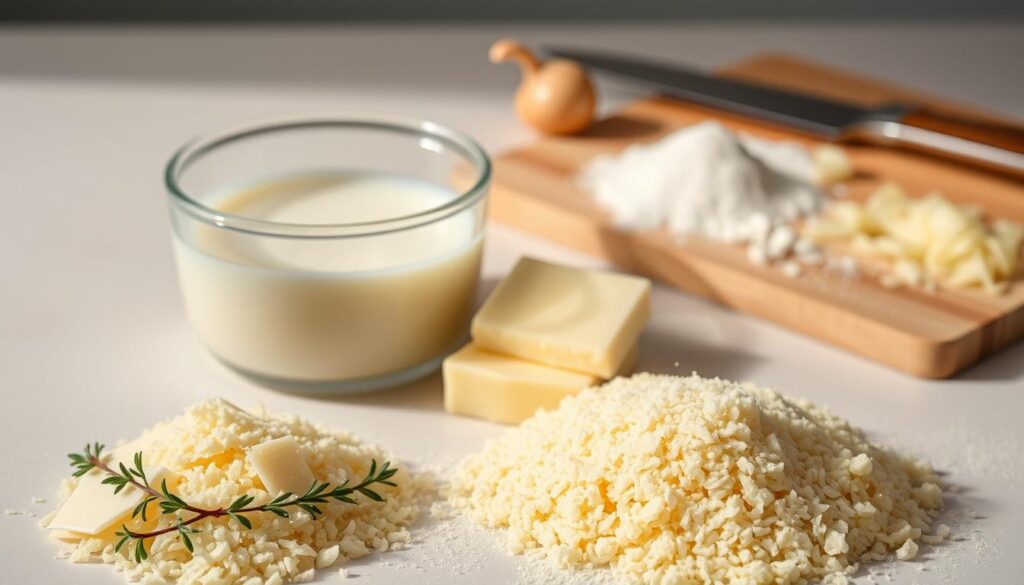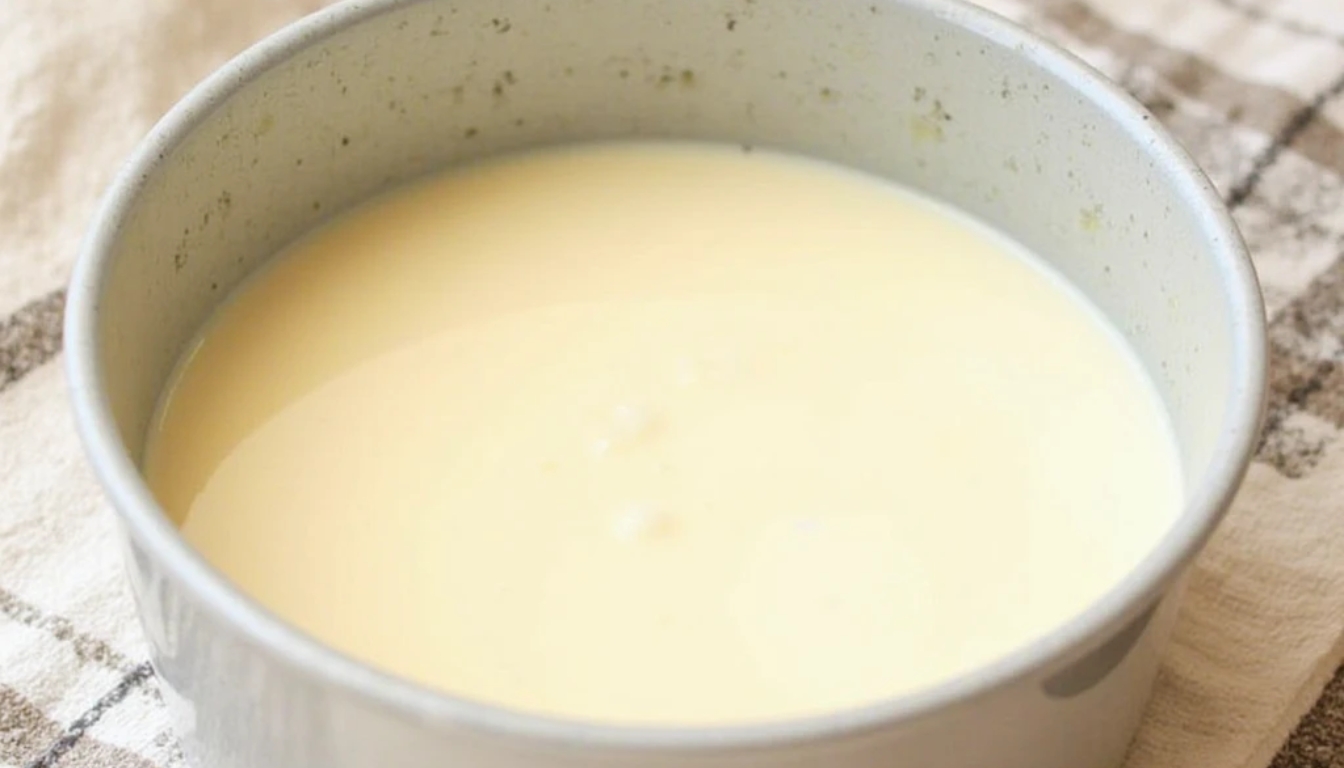Every great chef knows a perfect white sauce recipe can make a meal special. I remember watching my grandmother make a silky smooth homemade béchamel sauce. It turned a simple pasta dish into a masterpiece.
Creating a white sauce might seem hard, but it’s not. With the right techniques, anyone can make this classic French staple. This guide will help you make the perfect homemade béchamel sauce, whether you’re a home cook or a cooking enthusiast.
Table of Contents
Understanding the Basics of White Sauce

Making an easy white sauce is a key skill for both home cooks and chefs. This creamy sauce is the base of many classic dishes. It makes simple ingredients into culinary wonders.
What Makes a Perfect White Sauce
A perfect white sauce has a few important qualities:
- Smooth, lump-free consistency
- Balanced thickness
- Delicate flavor profile
- Proper temperature control
The Role of Roux in Sauce Making
The roux is the heart of your easy white sauce. It’s a mix of butter and flour that thickens your sauce. Cooking flour in fat gets rid of the raw taste, making your sauce smooth.
Classic vs Modern Variations
Traditional white sauce recipes are strict, but modern chefs love to mix things up. They try new thickeners, dairy-free options, and flavors. Your white sauce can be a classic béchamel or something new and exciting.
Learning to make white sauce opens up a world of possibilities. You can make dishes that taste like they’re from a restaurant, right in your kitchen.
Essential Ingredients for Classic Béchamel

Making a tasty white sauce begins with knowing its basic ingredients. The secret to a great white sauce is choosing top-notch parts that blend well together.
Your classic béchamel sauce needs a few key items. These turn simple pantry items into a creamy treat. Let’s look at what makes this sauce unique:
- Butter: The base of flavor, adding richness and smoothness
- All-purpose flour: Essential for a thickening base
- Whole milk: Gives creamy texture and a luxurious feel
- Salt: Boosts and balances the flavor
- Nutmeg: Adds a warm, subtle note
Choosing quality ingredients for your white sauce is key. Use unsalted butter with high butterfat and fresh whole milk. The right flour ensures smooth blending, and fresh spices add depth.
Professional chefs say to use room temperature ingredients for a silky sauce. With precise measurements and careful steps, these simple ingredients become a versatile dish.
Kitchen Tools and Equipment Needed
Making a tasty white sauce for pasta needs more than just ingredients. The right kitchen tools can turn a smooth, creamy sauce into a lumpy mess. Choosing the right equipment is key to making perfect white sauce every time.
When you’re ready to make white sauce, focus on three main areas of equipment:
Essential Cookware
- Heavy-bottomed saucepan: Important for even heat
- Non-stick pan for easy cleaning
- Stainless steel for professional results
Measuring Tools
- Liquid measuring cups with clear marks
- Dry ingredient measuring cups
- Precision kitchen scale for exact measurements
Mixing Utensils
- Whisk: Essential for a smooth sauce
- Wooden spoon for stirring
- Silicone spatula for scraping the edges
Quality kitchen tools can make your white sauce for pasta stand out. Each tool has a special role in making a creamy, lump-free sauce. This will surely impress your dinner guests.
White Sauce Recipe: The Traditional Method
Making the perfect bechamel sauce needs care and time. It’s a great white sauce that can make many dishes better with its creamy feel and deep taste.
To start making your white sauce, you’ll need these key ingredients:
- 5 tablespoons unsalted butter
- 1/4 cup all-purpose flour
- 1 quart whole milk
- 1 teaspoon salt
- 1/4 teaspoon ground nutmeg
First, melt the butter in a big saucepan over medium heat. It’s important to keep the heat right to avoid burning. When the butter is fully melted and bubbly, add the flour slowly while whisking. This makes a smooth roux.
| Cooking Stage | Key Action | Time Estimate |
|---|---|---|
| Butter Melting | Medium heat, constant stirring | 2-3 minutes |
| Roux Formation | Whisk flour into melted butter | 3-4 minutes |
| Milk Incorporation | Gradually add milk, continuous whisking | 5-7 minutes |
The secret to a great bechamel sauce is adding milk slowly and whisking all the time. Add the milk bit by bit, stirring well to avoid lumps. Keep cooking until it thickens and sticks to the spoon. Then, add salt and a bit of nutmeg for that classic taste.
Your homemade white sauce is now ready. Use it as a base for pasta, veggies, or as a tasty alfredo sauce alternative. It’s way better than store-bought.
Mastering the Perfect Roux Base
Starting a perfect white sauce recipe means mastering the roux base. This step is key for the sauce’s texture and taste. The roux turns simple ingredients into a creamy, rich sauce.
Proper Temperature Control
Temperature is key for a great roux. Cook it over medium-low heat. This way, the flour cooks slowly without burning.
Keep the heat even. This helps get rid of the raw flour taste and prevents scorching.
- Start with medium-low heat
- Stir constantly to prevent burning
- Watch for a pale, golden color
Achieving the Right Color
The color of your roux is very important. For a classic white sauce, aim for a pale blonde color. This color means the flour is cooked right, without any brown notes that could change the sauce’s taste.
Common Roux Mistakes to Avoid
New cooks often make mistakes with their roux. Rushing or using high heat can make the sauce grainy and bad-tasting. Take your time, be patient, and aim for a smooth mix.
- Don’t rush the cooking process
- Maintain consistent stirring
- Use a whisk for smooth integration
- Keep heat moderate
Learning these techniques will make your white sauce amazing. You’ll get a base that’s smooth, flavorful, and worthy of a restaurant.
Incorporating Milk and Achieving Smoothness
Making a smooth creamy pasta sauce is all about how you add milk to your roux. The trick is to add milk slowly and whisk constantly. This way, your sauce will go from lumpy to silky smooth.
First, warm your milk before mixing it with the roux. Cold milk can make the sauce clumpy. Here are some tips to get the sauce just right:
- Heat milk until it’s warm but not boiling
- Pour milk slowly into the roux
- Whisk continuously to prevent lumps
- Maintain medium-low heat throughout the process
Whisking is very important. Start with a little milk and whisk hard until it’s smooth. Then, add more milk slowly. This way, your sauce will be creamy and coat your pasta well.
Temperature is key. Keep the heat low and steady. If the sauce gets too hot, it can separate or form an unpleasant skin. Aim for a gentle heat that lets the sauce thicken without burning.
Pro tip: If lumps form, take the pan off the heat and whisk. The remaining heat will help smooth out the sauce without burning it.
Seasoning and Flavor Enhancements
Turning a simple white sauce into a masterpiece needs careful seasoning and creative touches. Learning how to make white sauce means mastering the art of seasoning. This can take your dish from good to great.
Traditional Spices that Define Flavor
Classic white sauce ingredients use a few key spices for depth and complexity:
- Salt: The basic seasoning that highlights the sauce’s natural taste
- White pepper: Adds a subtle heat without the black specks of black pepper
- Nutmeg: A traditional spice that adds a warm, slightly sweet flavor
Modern Flavor Innovations
Try new things with your white sauce by adding modern ingredients:
- Roasted garlic for a strong flavor
- Fresh herbs like thyme or basil
- Grated Parmesan or sharp cheddar cheese
Wine and Cream Enhancements
Professional chefs add liquids for more complex flavors. A bit of white wine or heavy cream can elevate your white sauce.
Pro tip: When trying new things with white sauce, start with small amounts. Taste as you go. This way, you keep the sauce’s balance while exploring new tastes.
Troubleshooting Common White Sauce Problems
Making a perfect white sauce for pasta can be tough, even for experts. Knowing how to fix common issues with the roux base sauce is key to mastering this classic technique.
When making white sauce, you might run into several common problems. These can mess up your dish’s quality. Let’s look at the most common issues and how to solve them:
- Lumpy Sauce: Avoid lumps by whisking constantly as you add milk to your roux base sauce. If lumps appear, use a hand mixer or strain the sauce through a fine-mesh sieve.
- Sauce Separation: Keep the heat moderate and stir often. If the sauce starts to separate, remove it from heat and whisk hard to mix everything back together.
- Scorching Prevention: Use a heavy-bottomed pan and keep the heat low. Stir often to stop the white sauce from burning.
Getting the right thickness is also important. If your sauce is too thick, slowly whisk in warm milk. If it’s too thin, cook it a bit longer or add a little more roux.
Professional chefs say to watch your sauce closely and adjust as needed. Practice and patience are essential to perfecting the white sauce technique.
Creative Variations and Uses
Learning to make a classic bechamel sauce opens up a world of possibilities. Your basic white sauce can turn into many tasty variations. These can make simple meals into something special.
Once you get the hang of making white sauce, you can try new flavors and uses. These will wow your family and friends at dinner.
Cheese Sauce Variations
Turn your white sauce into a creamy alfredo sauce with a few easy steps:
- Add sharp cheddar for a classic mac and cheese
- Blend in parmesan for an authentic Italian taste
- Mix gruyère for a fancy cheese sauce
Herb-Infused Options
Make your bechamel sauce even better with fresh herbs:
- Thyme for a deep, earthy flavor
- Basil for a bright, fresh taste
- Rosemary for a strong flavor
Diverse Culinary Applications
| Dish Category | White Sauce Application |
|---|---|
| Pasta Dishes | Base for lasagna, cannelloni |
| Casseroles | Binding agent for chicken pot pie |
| Vegetables | Creamy sauce for gratins |
Your homemade white sauce can be a versatile kitchen staple. It offers endless chances for creative cooking.
Storage and Reheating Tips
Keeping your homemade white sauce fresh is key. Knowing how to store and reheat it can greatly improve its taste and texture.
Proper Storage Guidelines
To keep your béchamel sauce creamy, follow these storage tips:
- Cool the sauce completely before storing
- Use an airtight container with a tight-fitting lid
- Place plastic wrap directly on the sauce surface to prevent skin formation
- Refrigerate immediately after cooling
Storage Duration and Safety
| Storage Location | Maximum Storage Time | Quality Preservation |
|---|---|---|
| Refrigerator | 3-4 days | Best quality maintained |
| Freezer | 1-2 months | Texture may slightly change |
Reheating Techniques
When reheating your white sauce, use gentle heat to keep it smooth. Avoid high heat, which can cause separation or burning. Here’s how to reheat your béchamel sauce:
- Reheat slowly on low stovetop heat
- Stir continuously to prevent scorching
- Add a small amount of milk if the sauce becomes too thick
- Use a double boiler for most consistent results
By following these tips, your white sauce will stay delicious and perfect for your favorite dishes.
Conclusion
Now you can make a tasty creamy pasta sauce easily. This guide has given you the key techniques and knowledge. You can turn simple ingredients into a smooth, flavorful white sauce.
Learning to make an easy white sauce takes practice and patience. Every try gets you closer to being a pro. Whether it’s a classic béchamel or something new, you’ll make sauces that taste like they’re from a restaurant.
Cooking is always a learning journey. Feel free to try new herbs, cheeses, or spices in your sauce. The skills you’ve learned can be used in many ways, letting you create sauces that are truly yours.
Your white sauce skills will help with many dishes, from fancy pasta to cozy casseroles. Enjoy the process, trust your taste, and relish the yummy results of your cooking adventures.
Tried Our Recipe Yet?
There are no reviews yet. Be the first one to write one.

